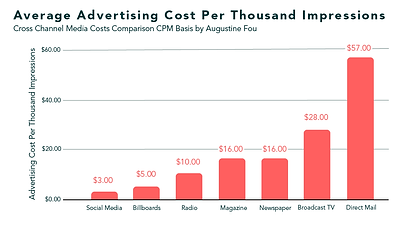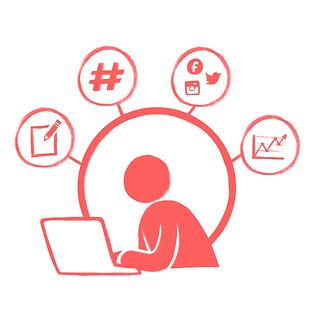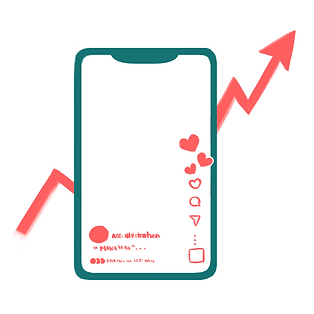RESEARCH
Algorithms vs. Artists
Social Media Algorithms & Pains
Social media has grown exponentially over the years and has allowed us to connect with friends, family, and other people worldwide creating thousands of online communities and businesses. Due to access to such a largely expanded audience we have seen people rise to fame and success creating content and completing work online ranging from business entrepreneurs to YouTubers and influencers.
With the development of social media there are now many different facets one must make themselves aware of in order to obtain and grow an audience, especially when starting off with a completely new account with no previous standing. When utilizing a new tool for success it is natural that there is a learning curve to understand how to use the tool to its full potential, but when combined with an unseen and unpredictable algorithm it can make that process confusing and even frustrating for some.

SOCIAL MEDIA ALGORITHMS ARE A WAY OF SORTING POSTS IN A USER'S FEED BASED ON RELEVANCY RATHER INSTEAD OF PUBLISH TIME
Brent Barnhart
Just like social media algorithms are constantly evolving and changing, making it hard to get a firm grip and understanding on how one should post and advertise themselves online. Back in 2020 artist Nana Williams shared her experience of posting her artwork in a way that would encourage people to like and save the post as that is what held the most weight for exposure on Instagram¹. Being that her experience was three years ago, does that same method still hold true with posts on Instagram today?
Another artist, Sara Tepes, shared her own personal experience and observations as an artist on Instagram. In a video she posted in 2022 she shared that each day she was losing 200 followers and that her total following remained stagnant for a year until she started to regularly post Instagram Reels². Despite the fact that Instagram started up as a photo sharing platform, it seems now that their algorithm is pushing for video posts rather than photo posts to push content forward. This can be especially frustrating for artists and other content creators as an entirely different skill set is needed to produce high quality and engaging videos. Such large and unpredictable changes can turn away artists and other content creators from utilizing sites like Instagram, discouraged and frustrated by a loss of audience and drops in engagement, but is there any reason for them to stay?
Why Social Media Matters
Despite the difficulties and challenges social media may bring, there is no doubt that it is one of the most useful tools for independent artists to utilize for two main reasons: advertising cost efficiency and access to a growing worldwide audience.
Utilizing social media is a cost effective way for an artist to promote their works to an audience in comparison to traditional media. Traditional forms of marketing can be identified as advertisements on newspapers, television, billboards, radio, direct mailing, and more³. In comparison, an artist could choose a specific social media platform and pay to promote a specific post, old or new, to be pushed to a specific audience which also helps to theoretically combat the algorithm.

The overall cost can be determined by cost per thousand impressions or CPM, this metric helps put into perspective how much an independent artist could expect to pay depending on the chosen method⁴. As we can see by the graphic, social media advertising is the most cost effective, averaging $3 CPM compared to the most expensive traditional format direct mail averaging $57 CPM.
The range between cost is large, and it should be taken into consideration when and how artists would utilize such traditional methods of marketing as well as which forms. In comparison, digital advertising through social media shows to be the most cost effective as well as being the best option for artists who mostly advertise themselves online rather than locally.
Social media also helps artists gain access to a worldwide audience that is expected to only grow. Instagram is a leading platform for marketers second to Facebook, and a popular choice for artists due to media visibility on profiles, and is expected to have their audience increase by ~39% by 2025⁵,⁶. This provides artists to promote themselves to a potential audience of 1.44 billion users online on top of cost efficiency of paid promotion.
With such a huge audience to have access too, even if an artist or content creator decides to not pay for online digital advertising they still have that audience access. Self-promotion online is already “free” in terms of posting online and utilizing hashtags to gain attention. With a singular post an artist advertises themselves in showcasing their skill and style of artwork, as well as giving insight to their own personality based on the written description that accompanies the visual media. The main problem with this is getting these posts that act as “promotion” to their intended target audience, made difficult by social media algorithms.
Marketing & Possible Methods
Knowing that social media provides positives of both “free” and cheap advertising and access to a worldwide audience, are there any actions artists can take themselves to try to increase their chances of getting noticed by their audience despite the algorithm? Ramos suggests that business owners should learn how to utilize both traditional and social media marketing strategies as 62% of owners lack the proper skills to market their content⁷. This is not to be confused with the forms of advertising, like how traditional advertising consists of newspaper ads and billboards, this is a focus on the skills and strategies related to traditional and social media means.
Traditional marketing skills include being able to strategize and plan out marketing while using target market data, being able to create cohesive copywrite, being able to manage public relationships with followers and other businesses, and more⁸. As for social media marketing skills, it covers things such as being able to create quality content, having an awareness of trends, understanding the unique advantages and features of different social media platforms, and utilizing data analytics and insights of audience and engagement⁹. Overall, these skills can help an artist or content-creator understand how to interact with their audience, how to present themselves, what kind of content they should be making as trends change, and how to best tailor that content based on data of their audience.

What is helpful is that social media sites tend to offer some type of business profile for users to help record data and audience analytics. Instagram is one such platform that provides this tool for free for users. Once a user decides to switch to a business profile, Instagram begins recording data to create analytics and metrics showcasing the performance and success of the users posts¹⁰. Looking at data and analytics can be scary especially for one unfamiliar with the process, but having the help of Instagram automatically collecting this data and providing a breakdown of it can help with the understanding of the users audience and what type of content performs best.
For artists in particular, it may be hard to post constantly and consistently depending on their unique workflow and speed in which they create new art. This can pose a challenge when it comes to creating a “schedule” or when trying to avoid long periods of silence between posts which can turn away followers. Tepes, as well as another artist named Janet, both recommend that to grow an audience quickly an artist should post multiple times a week and that one should “maximize” their content to be able to do so. The concept of “maximizing” one's content is creating multiple posts out of one piece of artwork. An example of this could be posting a sketch of a drawing, a few days later one could record a Reel showing the coloring process, and a few days after that the final drawing can be posted. Out of one drawing multiple posts can be created, making it easier to post multiple times a week as opposed to posting one finished drawing.

Paid promotion is another option as mentioned in the previous section. To use Instagram as an example again, they offer a ‘boost’ feature for business profiles that can be used on either new or existing posts and allow the user to choose their target audience as well as the duration of the advertisement¹¹. Like everything else, even paid advertisements can have success that varies from person to person but will most likely result in overall favorable results.
Carter is one such person who experimented to see the success of ‘boosting’ a post. He spent $50 to boost an already existing post for two days, from there the post received 33,362 impressions from an estimated 7,600 to 22,000 impressions from Instagram, as well as 571 post interactions, 1,141 likes, and 45 new followers¹².
Overall, there are a variety of skills, methods, and tools that an artist and other content creators can and should use but ultimately each individual experience will be unique. What works for one person may not work for another, but that’s okay. Even with these skills and the struggle against trying to find an advantage over the algorithm, perhaps what is needed the most is perseverance and determination to keep learning and posting.
FOOTNOTES
1. Russell, Anna M. “Folk Art on the Internet: Artists Building Community and Marketplace on Social Media.” Fashion Institute of Technology, State University of New York, Ann Arbor, 2020. ProQuest, http://libproxy.westoahu.hawaii.edu/login?url=https://www.proquest.com/dissertations-theses/folk-art-on-internet-artists-building-community/docview/2486547991/se-2.
2. Tepes, Sara. How I Gained 50l Followers in 3 months on Instagram (and How You Can Do it Too). May 2022. https://youtu.be/erK8FhVOZ-U
3. Chinen-Moore, Joanne. Social Media Strategies for Small Businesses, Walden University, Ann Arbor, 2020. ProQuest, http://libproxy.westoahu.hawaii.edu/login?url=https://www.proquest.com/dissertations-theses/social-media-strategies-small-businesses/docview/2420559389/se-2.
4. LYFE Marketing. “Traditional Media vs. Social Media Advertising.” https://www.lyfemarketing.com/traditional-media-versus-social-media/
5. Statista Research Department. “Leading Social Media Platforms Used by Marketers Worldwide As of January 2022.” https://www-statista-com.libproxy.westoahu.hawaii.edu/statistics/259379/social-media-platformstista-used-by-marketers-worldwide/
6. Statista Research Department. “Number of Instagram Users Worldwide from 2020 to 2025.” https://www-statista-com.libproxy.westoahu.hawaii.edu/statistics/183585/instagram-number-of-global-users/
7. Ramos, Damaris. Social Media Marketing Strategies for Increasing Small Businesses’ Revenues, Walden University, Ann Arbor, 2021. ProQuest, http://libproxy.westoahu.hawaii.edu/login?url=https://www.proquest.com/dissertations-theses/social-media-marketing-strategies-increasing/docview/2561893911/se-2.
8. Digital Marketing Institute. “The Traditional Marketing Skills You Should Still Be Using.” Digital Marketing Institute, December 2016. https://digitalmarketinginstitute.com/blog/the-traditional-marketing-skills-you-should-still-be-using
9. BrainStation. “Skills For Social Media Marketing.” https://brainstation.io/career-guides/what-skills-do-you-need-to-be-a-social-media-specialist
10. Warren, Jillian. “The Ultimate Guide to Instagram Analytics.” November 2021. https://later.com/blog/instagram-analytics/#:~:text=Once%20you%20have%20an%20Instagram,your%20business%20or%20creator%20profile.
11. Instagram. “Boost Instagram Posts.” Meta. https://business.instagram.com/boost-instagram-posts/get-started
12. Carter, Nick. “Do Instagram Promotions Work? What $50 Will Get You!” July 2020. https://youtu.be/EYZsSKfe3L0


